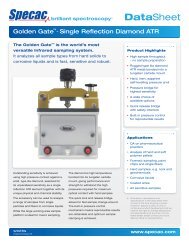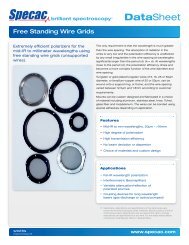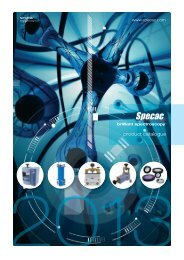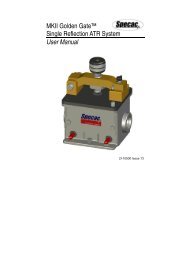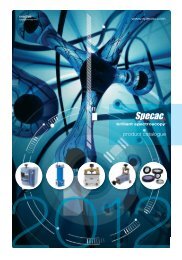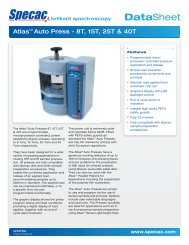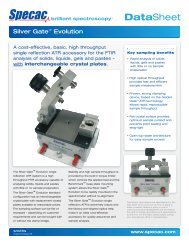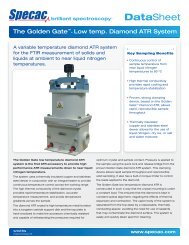2011 Product Catalogue - Specac
2011 Product Catalogue - Specac
2011 Product Catalogue - Specac
- TAGS
- product
- catalogue
- specac
- specac.com
Create successful ePaper yourself
Turn your PDF publications into a flip-book with our unique Google optimized e-Paper software.
<strong>Specac</strong> <strong>Product</strong> <strong>Catalogue</strong> <strong>2011</strong> | A-Z of IR<br />
A-Z of IR<br />
100% Line<br />
Ratio of two background spectra under identical<br />
conditions. Determines condition of<br />
spectrometer, or accessory, and quality of<br />
spectra. An ideal 100% Line would be a horizontal<br />
line at 100%.<br />
A<br />
Absorbance<br />
The amount of Infrared radiation absorbed by a<br />
sample. It is proportional to concentration, and is<br />
defined by Beer’s Law, so it can be used for<br />
Quantitative Analysis. Often the Y-axis unit in<br />
Infrared spectra, absorbance is related to<br />
transmittance by A=log10 (1/T), where A is the<br />
absorbance and T is the transmittance.<br />
Attenuated Total Reflectance (ATR)<br />
A reflectance sampling technique, used in such<br />
accessories as the Golden Gate and the<br />
Benchmark 6 Reflection ATR System. A beam of<br />
Infrared radiation is passed through a prism of<br />
material which is Infrared transparent, and has a<br />
high refractive index, at least higher than the<br />
sample being analyzed. Due to internal<br />
reflectance, the light reflects off the surface of<br />
the crystal at least once, setting up an<br />
evanescent wave, which extends into the sample<br />
by typically a few microns. The sample must be<br />
held in intimate contact with the crystal.<br />
B<br />
Background Spectrum<br />
A single beam spectrum produced without a<br />
sample in the Infrared beam. It is used to record<br />
the contributions that the instrument and the<br />
environment make to the measurement.<br />
The sample spectrum can be ratioed against the<br />
background spectrum to remove these<br />
contributions.<br />
Baseline correction<br />
The manipulation of a spectrum to correct a<br />
sloped or curving baseline. The spectroscopist<br />
draws a function parallel to the baseline which is<br />
then subtracted from the spectrum.<br />
Beamsplitter<br />
An optical device which reflects half the radiation<br />
striking it, and transmits half.<br />
106<br />
Benchmark<br />
<strong>Specac</strong>’s universal compatibility baseplate<br />
system, adapting <strong>Specac</strong> accessories to all<br />
spectrometer models. Also <strong>Specac</strong>’s 6 Reflection<br />
ATR System, capable of analyzing almost any<br />
sample.<br />
C<br />
Calibration<br />
In Quantitative Analysis, the correlation of peak<br />
heights and areas in a spectrum with the<br />
concentrations of standard analytes. After<br />
calibration, unknown analyte concentrations can<br />
be calculated.<br />
Calibration curve<br />
An Absorbance vs. Concentration plot used in<br />
calibration. If the sample obeys Beer’s Law, the<br />
plot will be linear and unknown concentrations<br />
can be calculated.<br />
Condenser<br />
The optical element that condenses light on a<br />
sample.<br />
Critical Angle<br />
Defined as being:<br />
c = arcsin (n1/n2)<br />
where c is the critical angle for an interface<br />
between two specific media, n1 and n2 are the<br />
refractive indices of the two media and n 2 has<br />
the higher refractive index; the critical angle is the<br />
smallest angle of incidence at which total<br />
internal reflection occurs.<br />
D<br />
Depth of Penetration<br />
When a sample is analyzed using ATR, the depth<br />
of penetration is the depth at which the<br />
evanescent wave has decreased to 1/e (or<br />
36.788%) of its original value after penetrating<br />
the sample. The depth of penetration is<br />
dependent on many factors, including the angle<br />
of incidence, the refractive index of the ATR<br />
crystal, and the wavelength of the Infrared<br />
radiation.<br />
Cont’d<br />
www.specac.com



